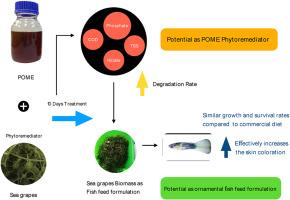海葡萄(Caulerpa racemosa)作为棕榈油厂污水植物修复剂和观赏鱼饲料配方的双重功能。
IF 8.1
2区 环境科学与生态学
Q1 ENVIRONMENTAL SCIENCES
引用次数: 0
摘要
植物修复是处理棕榈油厂废水(POME)的一项前景广阔的技术。此外,植物修复剂还具有多种应用潜力,包括用作原料。因此,本研究旨在阐明海葡萄(Caulerpa racemosa)修复 POME 的能力,并评估其作为观赏鱼饲料的适宜性。结果表明,施用海葡萄可有效降低 POME 中的 COD、TSS、磷酸盐(PO43-)和硝酸盐(NO3-)水平。海葡萄在 POME 中的浓度为 12.5%,其降低率和生长性能最高。此外,修复过程中产生的海葡萄生物质可用作观赏鱼的饲料原料,其表现为鱼的皮肤颜色增加。这项研究首次提供了利用海葡萄管理 POME 的可持续方案,并建议将海葡萄作为观赏鱼的潜在鱼饲料配方。本文章由计算机程序翻译,如有差异,请以英文原文为准。

Dual function of sea grapes (Caulerpa racemosa) as phytoremediator for palm oil mill effluent and as ornamental fish feed formulation
Phytoremediation is a promising technology for treating Palm Oil Mill Effluent (POME). Moreover, phytoremediators have the potential for various aplication, including as feedstock. Hence, this study aims to elucidate the ability of sea grapes (Caulerpa racemosa) in remediating POME and evaluate their suitability as ornamental fish feed. Results showed that application of sea grapes effectively decreased the COD, TSS, phosphate (PO43−), and nitrate (NO3−) levels in POME. Sea grapes maintained in POME with a concentration of 12.5% had the highest reduction rate and growth performance. Moreover, sea grapes biomass from the remediation process can be utilized as feed material for ornamental fish, as indicated by increasing skin coloration of fish. For the first time, this study provides sustainable options for managing POME using sea grapes and suggests sea grapes as a potential fish feed formulation for ornamental fish.
求助全文
通过发布文献求助,成功后即可免费获取论文全文。
去求助
来源期刊

Chemosphere
环境科学-环境科学
CiteScore
15.80
自引率
8.00%
发文量
4975
审稿时长
3.4 months
期刊介绍:
Chemosphere, being an international multidisciplinary journal, is dedicated to publishing original communications and review articles on chemicals in the environment. The scope covers a wide range of topics, including the identification, quantification, behavior, fate, toxicology, treatment, and remediation of chemicals in the bio-, hydro-, litho-, and atmosphere, ensuring the broad dissemination of research in this field.
 求助内容:
求助内容: 应助结果提醒方式:
应助结果提醒方式:


